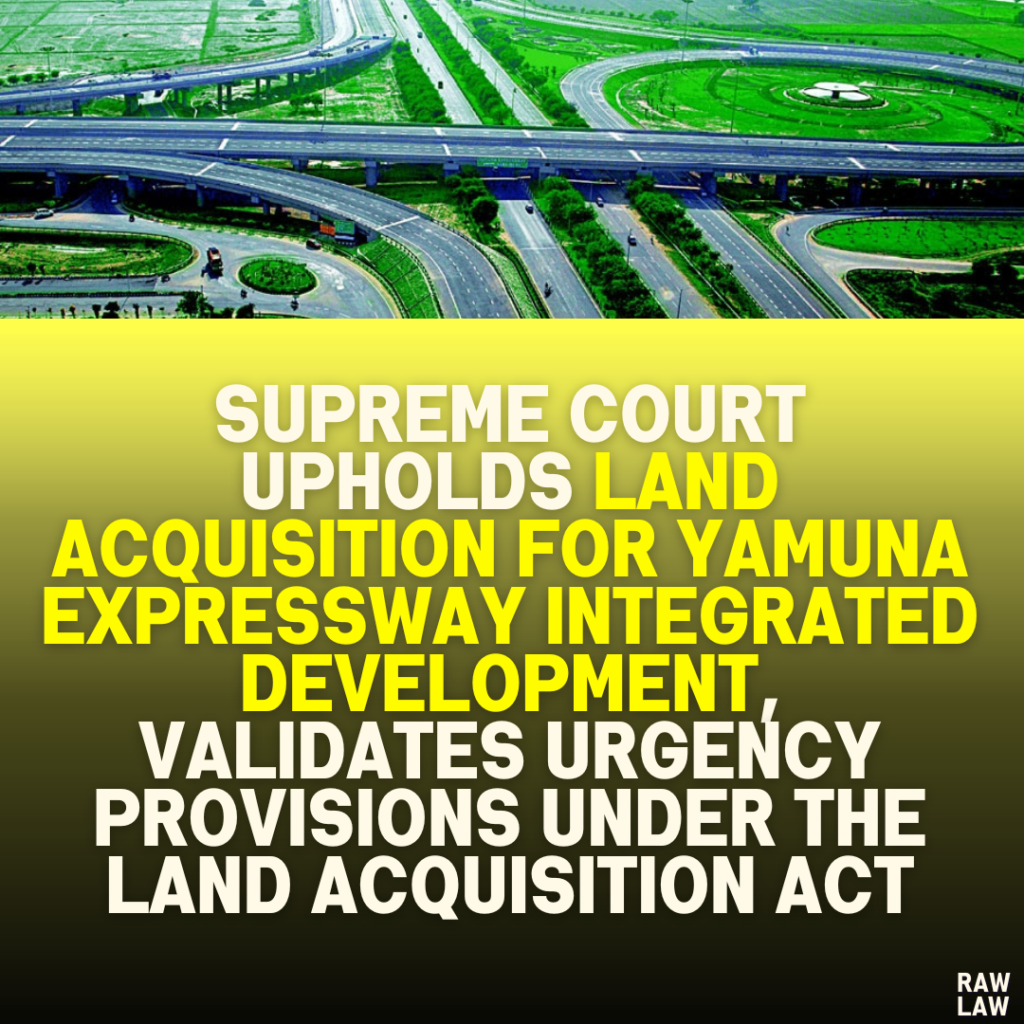Court’s Decision:
The Supreme Court upheld the legality of the land acquisition by the Yamuna Expressway Industrial Development Authority (YEIDA) for an integrated development project, including the Yamuna Expressway and its adjoining areas. The Court ruled that the invocation of urgency provisions under Sections 17(1) and 17(4) of the Land Acquisition Act, 1894, was lawful and essential for timely execution of the project. It affirmed the decision in Kamal Sharma v. State of U.P. while setting aside Shyoraj Singh v. State of U.P. as per incuriam for failing to consider binding precedents.
Facts:
The acquisition concerned land in Gautam Budh Nagar, Uttar Pradesh, intended for planned development through YEIDA. The urgency provisions were invoked to expedite the process, bypassing the requirement for objections under Section 5-A of the Act.
The Allahabad High Court had delivered contradictory judgments in two cases:
- In Kamal Sharma, the Court upheld the acquisition, emphasizing the integrated nature of the project and citing significant public interest.
- In Shyoraj Singh, the Court quashed the acquisition, reasoning that the urgency provisions were arbitrarily applied without sufficient justification.
These conflicting rulings led to appeals by landowners and YEIDA before the Supreme Court.
Issues:
- Whether the acquisition was an integral part of the Yamuna Expressway’s development plan.
- Whether the urgency provisions were validly invoked under Sections 17(1) and 17(4) of the Act.
- Which High Court judgment—Kamal Sharma or Shyoraj Singh—correctly interpreted the law.
Petitioner’s Arguments (Landowners):
- Arbitrary Invocation of Urgency Provisions: The government failed to justify urgency, as the time taken to issue notifications (nearly a year) contradicted claims of emergency.
- Denial of Section 5-A Rights: The urgency provisions deprived landowners of the right to object, which they claimed is a fundamental right.
- Misapplication of Precedent: The High Court in Kamal Sharma ignored Radhy Shyam v. State of U.P., which ruled that urgency provisions cannot be mechanically applied to planned developments.
Respondent’s Arguments (YEIDA):
- Integrated Development Plan: The acquisition was part of a large-scale integrated development plan involving the Yamuna Expressway, residential zones, industrial areas, and recreational facilities.
- Public Importance: The Yamuna Expressway is a vital infrastructure project with immense public benefits, including reduced travel time, economic growth, and connectivity to the upcoming Jewar Airport.
- Judicial Precedents: Relying on Nand Kishore Gupta v. State of U.P., the respondents argued that such acquisitions for integrated projects had previously been upheld.
- Limited Scope of Judicial Review: The decision to invoke urgency provisions is administrative, requiring subjective satisfaction of the government. Courts can only review the process, not the decision itself.
Analysis of the Law:
Urgency Provisions:
Sections 17(1) and 17(4) allow the government to expedite land acquisition for urgent projects by bypassing Section 5-A objections. Courts have previously upheld such provisions when justified by public interest and supported by sufficient material.
Precedent Analysis:
- Nand Kishore Gupta: The Court upheld the acquisition for the Yamuna Expressway and adjoining developments, emphasizing the project’s integrated nature and public benefit.
- Radhy Shyam: This case dealt with a standalone industrial project, and the Court held that urgency provisions could not be invoked arbitrarily. The Court clarified that the precedent in Nand Kishore was distinguishable as it pertained to an integrated development project.
- Distinction in Present Case: The Supreme Court noted that the acquisition here mirrored Nand Kishore in its integrated nature, involving both the expressway and associated land parcels for complementary development. It found Radhy Shyam inapplicable.
Court’s Reasoning:
- Integrated Nature of the Project: The Yamuna Expressway’s development, including adjoining areas for residential, commercial, and industrial purposes, was part of a unified plan. Such projects inherently require urgency to ensure timely execution and avoid fragmentation.
- Public Interest: The project benefits millions of commuters, fosters economic development, and creates employment opportunities. Its connectivity to Jewar Airport further enhances its significance.
- Procedural Compliance: The State government’s decision to invoke urgency provisions was supported by adequate material, including the enormity of the project, potential delays, and the number of affected landowners.
- Flawed Judgment in Shyoraj Singh: The High Court failed to consider earlier precedents like Nand Kishore and similar cases affirming the legality of urgency provisions for integrated projects.
Conclusion:
- Validation of Acquisition: The Supreme Court held that the acquisition formed an integral part of the Yamuna Expressway project and justified the invocation of urgency provisions under the Act.
- Rejection of Shyoraj Singh: The judgment was declared per incuriam for overlooking binding precedents and failing to appreciate the integrated nature of the project.
- Compensation: The Court upheld the High Court’s direction in Kamal Sharma for an enhanced compensation of 64.7% as a “No Litigation Bonus.”
Implications:
- Legal Precedent: The judgment reinforces the principle that integrated development projects with substantial public benefit justify invoking urgency provisions.
- Consistency in Judicial Decisions: The ruling emphasizes adherence to precedent and objective evaluation of the material justifying urgency.
- Land Acquisition Practices: Governments may invoke urgency provisions for projects of national importance, provided there is sufficient evidence of genuine urgency and public interest.
This ruling solidifies the balance between expeditious development and landowners’ rights, providing clarity on the application of urgency provisions.




Pingback: Himachal Pradesh High Court Upholds Interim Bail in Sharp Weapon Assault Case and states that “Custodial Interrogation Not Justified” - Raw Law